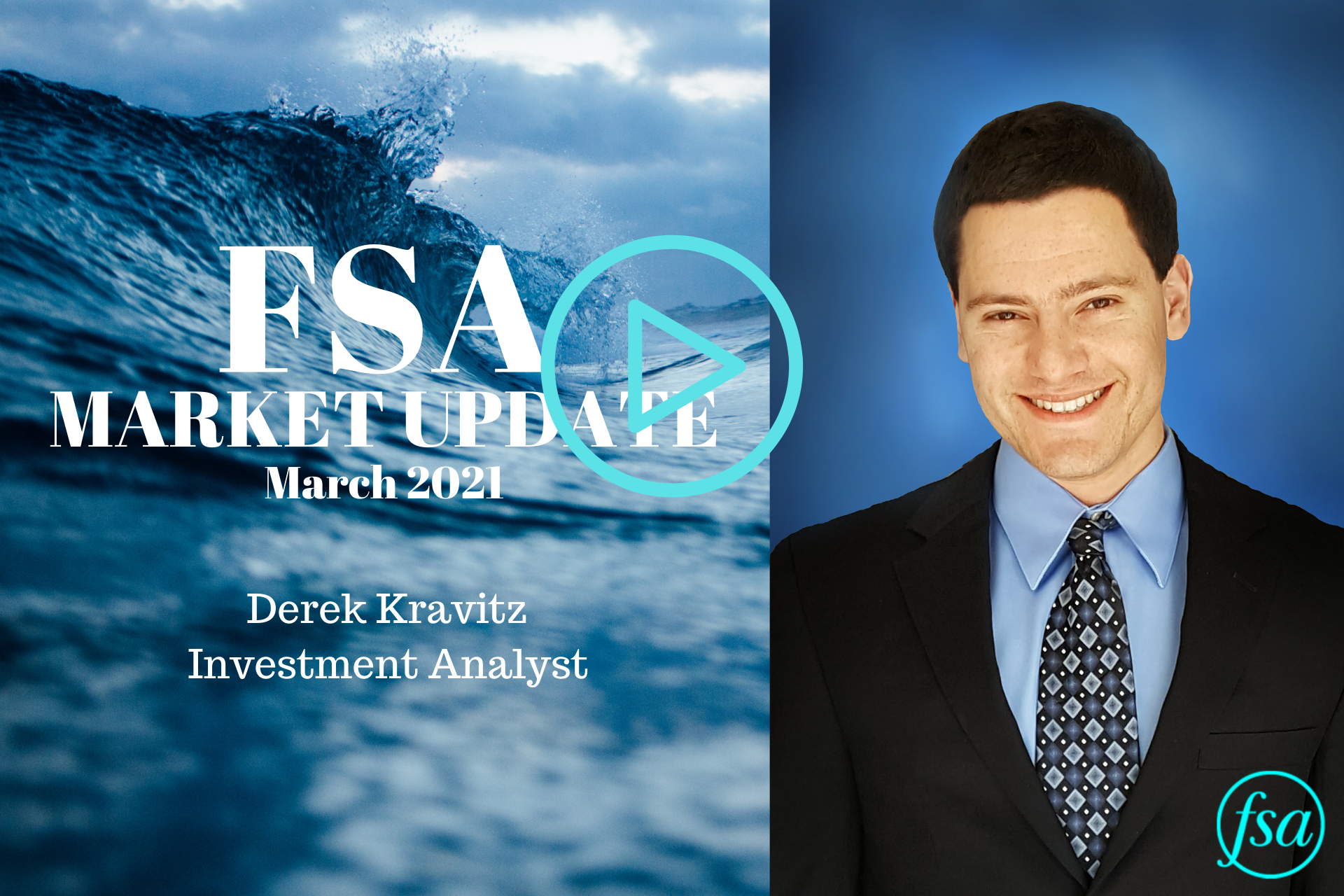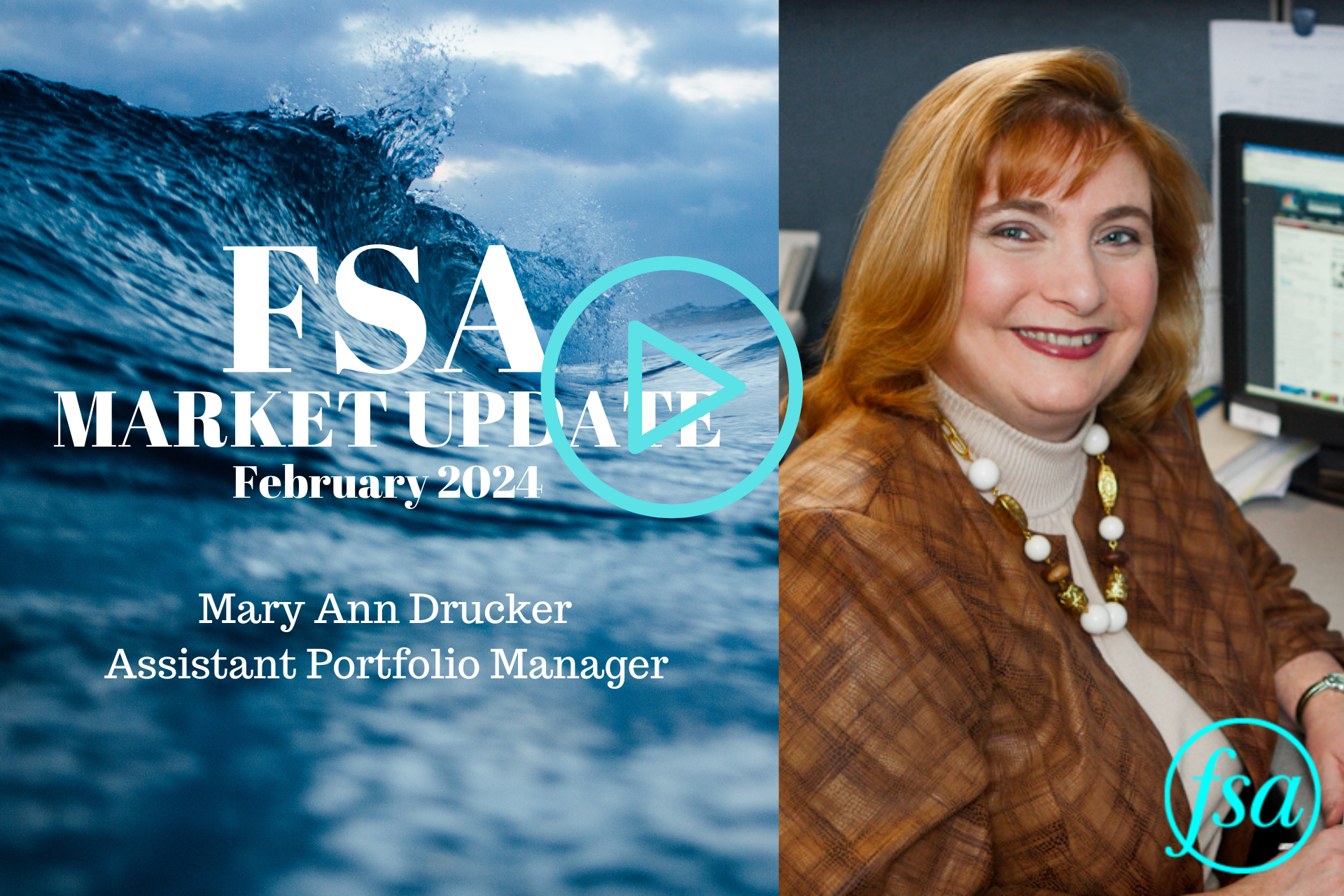If inflation were to result from all of this stimulus, what would that look like in today’s market environment? And what could it mean for the markets and your portfolio? Derek Kravitz, Investment Analyst, discusses this in our March 2021 video market update.
March Stock Market Update Transcript
Hi, everyone. This is Derek, the investment analyst with FSA, here with your March 2021 market update. We’ve been hearing a lot of discussion lately surrounding the possibility for higher inflation and its potential ramifications on the markets. In fact, the threat of inflation is what spooked equity and bond markets in the final week of February as the 10-year Treasury yield spiked to 1.6% in a very short time period. Given the record amount of pandemic-related economic stimulus that’s been transpiring, it makes sense that we would hear talk of inflation. If inflation were to result from all of this stimulus, what would that look like in today’s market environment? And what could it mean for the markets and your portfolio?
First, let’s start with the definition of inflation. Inflation is what occurs when the purchasing power of your currency declines against the basket of goods and services that contains everyday consumables, such as foods, TVs, gasoline, housing, healthcare, et cetera. One way inflation can rise is when too many units of a currency are chasing too few of these goods produced by an economy. This is the risk that we’re facing as the U.S. government continues to pass further COVID stimulus bills. Will the economy be able to handle the influx of new money without seeing an increase in the prices we pay as consumers for these everyday items?
Now some of you may be thinking, “Inflation is already here; just look at my healthcare premiums and the cost of tuition to send my child to college.” Now, while it is absolutely the case that some parts of the economy have seen larger and faster pricing increases than other parts of the economy, overall, inflation has remained subdued given that there is a basket of goods that we talked about just a second ago. Some of these goods have actually seen their prices stay flat over the preceding two decades, and in some cases, they have even declined in large parts of global trade and technological advances. This has resulted in a subdued overall U.S. Inflation rate over the past two decades.
Economics professor Mark Perry of the American Enterprise Institute created a somewhat famous chart that he updates annually that illustrates this phenomenon. You may have seen snippets of this in newspapers or magazines or even on TV in the past. Now, when inflation is kept under control, it can actually be a net benefit to the economy as it encourages investment. In fact, for this reason, the Federal Reserve actively targets a 2% overall inflation rate, in the long run as part of its mandate to achieve full employment in the economy.
But what would a world of higher overall inflation than we’ve been accustomed to look like? Well, in some areas of the economy, inflationary pressures are already present even without the economy having returned to a fully reopened status. For example, according to Ned Davis Research, lumber has seen its price triple since its April 2020 lows, fueled by a surging housing demand, coupled with pandemic-related supply chain disruptions. As a result, any products, like housing, that take lumber as a key raw material input will have a higher price tag.
As we look to the future, another easy inflationary scenario to imagine is that as we exit the COVID-19 pandemic, suddenly everybody wants to take a vacation and the price of flights, rental cars, hotels, theme park tickets, and anything else associated with the traditional American summer vacation increases by a noticeable amount. While these examples may seem relatively isolated, higher prices in one area can have ripple effects throughout other areas of the economy as well. If enough pockets of the economy see simultaneous price increases, the overall U.S. Inflation rate will rise faster than it has in recent years.
Currently, the consensus among economists and professional investors is that 2021 will, at the very least, experience a temporary pop in inflation from continued economic stimulus and a reopened economy where consumers spend money that they weren’t able to in 2020. While it may be irritating to have to pay more for a product or service as we compete with other fellow consumers, the alternative of everybody being unable to go out and spend money is far more detrimental to the health of the economy. While historical stock market returns during inflationary periods are mixed, a higher inflation rate can have plenty of varying effects on the markets, from a boost in the stocks of energy-producing companies or a decrease in the price of U.S. Treasury bonds, both of which we have already witnessed here in 2021.
At FSA, we’re constantly monitoring the markets to allocate towards areas that are outperforming, regardless of what the macroeconomic backdrop may be. As an active manager, we have an advantage in that we can quickly pivot to capitalize on new market trends as they emerge. If we do in fact enter a period of higher inflation, we will adjust the portfolios as necessary to protect against, and maybe even benefit from, inflationary effects.
Now for a quick portfolio update. As mentioned in the beginning, February did experience a small pullback in the markets due to concerns over inflation. However, we remain fully invested during this time period because the pullback was not large enough to activate our safety nets. We continue to shift some of the equity allocations of portfolios towards funds that are composed of smaller companies, also known as small caps, and international companies. Both areas have done extraordinarily well since about election time of last year with the Russell 2000, a broad-based small capitalization index, rising over 40% and the MSCI Emerging Markets Index rising over 22%. We also recently allocated towards some value-oriented funds that will benefit if energy prices continue to rise.
As always, please feel free to reach out to us with any questions or comments at questions@FSAinvest.com.
For your March 2021 market update, this has been Derek, the investment analyst. Thank you for watching, and we’ll see you next time.
FSA’s current written Disclosure Brochure and Privacy Notice discussing our current advisory services and fees is available at www.FSAinvest.com/disclosures or by calling 301-949-7300.




